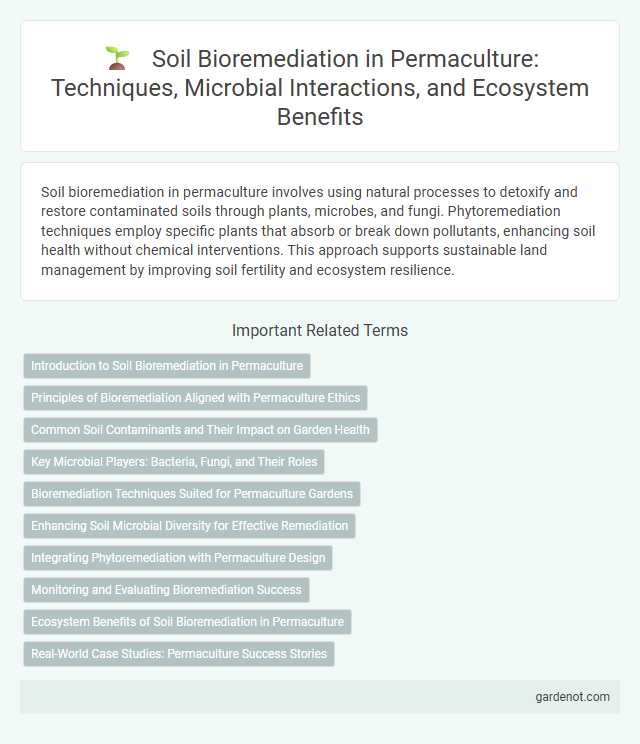Soil bioremediation in permaculture involves using natural processes to detoxify and restore contaminated soils through plants, microbes, and fungi. Phytoremediation techniques employ specific plants that absorb or break down pollutants, enhancing soil health without chemical interventions. This approach supports sustainable land management by improving soil fertility and ecosystem resilience.
Introduction to Soil Bioremediation in Permaculture
Soil bioremediation in permaculture harnesses natural processes using plants, microbes, and fungi to detoxify and restore contaminated soils. Techniques such as phytoremediation, mycoremediation, and microbial augmentation improve soil health and enhance ecosystem resilience. This sustainable approach supports productive, pollutant-free land, integral to permaculture design principles.
Principles of Bioremediation Aligned with Permaculture Ethics
Bioremediation in permaculture harnesses natural processes to detoxify soil contaminants using plants, microbes, and fungi, emphasizing earth care and fair share ethics. Principles include promoting biodiversity, maintaining soil health, and enhancing ecosystem resilience through phytoremediation and microbial activity. Techniques align with permaculture's commitment to sustainable, regenerative land stewardship by restoring soil vitality without harmful interventions.
Common Soil Contaminants and Their Impact on Garden Health
Common soil contaminants such as heavy metals, pesticides, petroleum hydrocarbons, and excessive fertilizers disrupt garden health by impairing soil microbial diversity and nutrient cycling. These pollutants reduce soil fertility, hinder plant growth, and increase susceptibility to diseases, ultimately diminishing crop yields and biodiversity. Implementing soil bioremediation techniques restores soil quality by breaking down toxic substances and revitalizing essential biological functions within the garden ecosystem.
Key Microbial Players: Bacteria, Fungi, and Their Roles
Soil bioremediation in permaculture relies heavily on key microbial players such as bacteria and fungi, which work synergistically to degrade pollutants and restore soil health. Bacteria like Pseudomonas and Bacillus species break down hydrocarbons and heavy metals, while fungi such as mycorrhizal and white-rot fungi enhance organic matter decomposition and nutrient cycling. These microorganisms not only detoxify contaminants but also improve soil structure and fertility, promoting sustainable ecosystem recovery.
Bioremediation Techniques Suited for Permaculture Gardens
Bioremediation techniques suited for permaculture gardens include phytoremediation, mycoremediation, and microbial sourcing, which leverage plants, fungi, and beneficial microbes to detoxify soil contaminants. Phytoremediation uses hyperaccumulator plants such as sunflowers and mustard greens to absorb heavy metals, while mycoremediation employs fungi like oyster mushrooms to break down hydrocarbons and pesticides. Incorporating compost and biochar enhances microbial activity, promoting the natural breakdown of toxins and restoring soil health sustainably.
Enhancing Soil Microbial Diversity for Effective Remediation
Enhancing soil microbial diversity is crucial for effective soil bioremediation, as diverse microbial communities improve the breakdown of contaminants through synergistic metabolic pathways. Introducing bioaugmentation strategies using native and specialized microbes can accelerate pollutant degradation, restoring soil health and function. Optimizing soil conditions such as moisture, pH, and organic matter content supports microbial activity and diversity, thereby maximizing remediation efficiency.
Integrating Phytoremediation with Permaculture Design
Integrating phytoremediation into permaculture design leverages deep-rooted plants such as willows, sunflowers, and vetiver grass to naturally extract contaminants like heavy metals and pesticides from soil. This method enhances soil health by restoring microbial diversity and nutrient cycles while maintaining ecosystem resilience. By combining phytoremediation with permaculture principles, land regeneration becomes sustainable, promoting long-term productivity and ecological balance.
Monitoring and Evaluating Bioremediation Success
Effective soil bioremediation in permaculture requires consistent monitoring of microbial activity, contaminant levels, and soil health indicators such as nutrient content and pH. Evaluating bioremediation success involves measuring reductions in pollutants like heavy metals or hydrocarbons alongside improvements in soil biodiversity and structure. Utilizing tools like gas chromatography, spectrophotometry, and bioassays ensures precise tracking of contaminant degradation and ecosystem recovery.
Ecosystem Benefits of Soil Bioremediation in Permaculture
Soil bioremediation in permaculture enhances soil health by naturally breaking down contaminants, leading to improved microbial diversity and nutrient cycling essential for plant growth. This process supports ecosystem resilience, promotes sustainable land use, and increases soil fertility without chemical interventions. By restoring soil functionality, bioremediation contributes to cleaner groundwater, healthier food production, and long-term environmental stability.
Real-World Case Studies: Permaculture Success Stories
Soil bioremediation in permaculture has demonstrated remarkable success in restoring contaminated sites through natural processes involving plants, microbes, and fungi. Real-world case studies reveal how permaculture practitioners revitalized toxic soils, such as heavy metal-polluted urban plots and pesticide-affected farmland, by integrating hyperaccumulator plants and mycorrhizal fungi to enhance soil health and biodiversity. These successes highlight permaculture's capacity to turn degraded soils into productive ecosystems, supporting sustainable agriculture and environmental regeneration.
Soil bioremediation Infographic

 gardenot.com
gardenot.com